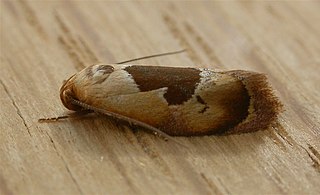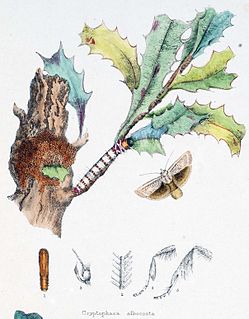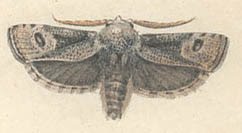Related Research Articles

Hoplomorpha camelaea is a moth in the family Oecophoridae first described by Edward Meyrick in 1888. It is found in Australia, where it has been recorded from Victoria, Queensland, New South Wales and the Australian Capital Territory.
Trichoptilus scythrodes is a moth of the family Pterophoridae that can be found in Australia, including New South Wales and South Australia.
Criophthona trileuca is a moth in the family Crambidae. It is found in Australia, where it has been recorded from Western Australia.
Eucryptogona trichobathra is a moth in the family Eriocottidae described by Oswald Bertram Lower in 1901. It is found in the Australian state of New South Wales.
Dorycnopa orthodesma is a moth of the family Gelechiidae. It was described by Oswald Bertram Lower in 1901. It is found in Australia, where it has been recorded from New South Wales.
Timyra autarcha is a moth in the family Lecithoceridae. It was described by Edward Meyrick in 1908. It is found in southern India.
Zaphanaula hemileuca is a moth in the family Xyloryctidae, and the only species in the genus Zaphanaula. It was described by Turner in 1896. It is found in Australia, where it has been recorded from Queensland.
Clerarcha dryinopa is a moth in the family Xyloryctidae. It was described by Edward Meyrick in 1890. It is found in Australia, where it has been recorded from the Australian Capital Territory, New South Wales and Victoria.
Cryptophasa hormocrossa is a moth in the family Xyloryctidae. It was described by Edward Meyrick in 1925. It is found on New Guinea.
Cryptophasa mesotoma is a moth in the family Xyloryctidae. It was described by Edward Meyrick in 1925. It is found on Buru in the Maluku Islands.
Cryptophasa nephrosema is a moth in the family Xyloryctidae. It was described by Turner in 1898. It is found in Australia, where it has been recorded from Queensland and the Northern Territory.
Cryptophasa opalina is a moth in the family Xyloryctidae. It was described by Turner in 1900. It is found in Australia, where it has been recorded from the Northern Territory, Queensland and Western Australia.
Cryptophasa isoneura is a moth in the family Xyloryctidae. It was described by Oswald Bertram Lower in 1902. It is found in Australia, where it has been recorded from Queensland, South Australia and Victoria.

Cryptophasa albacosta, the small fruit tree borer, is a moth in the family Xyloryctidae. It was described by John Lewin in 1805. It is found in Australia, where it has been recorded from New South Wales, Queensland, South Australia, Tasmania and Victoria.

Cryptophasa irrorata is a moth in the family Xyloryctidae. It was described by John Lewin in 1805. It is found in Papua New Guinea and Australia, where it has been recorded from the Australian Capital Territory, New South Wales, Queensland and South Australia.
Cryptophasa melanoscia is a moth in the family Xyloryctidae. It was described by Oswald Bertram Lower in 1903. It is found in Australia, where it has been recorded from Victoria.
Xylorycta chrysomela is a species of moth in the family Xyloryctidae. It was described by Oswald Bertram Lower in 1897. It is found in Australia, where it has been recorded from the Northern Territory and Queensland.
Antaeotricha phryactis is a moth in the family Depressariidae. It was described by Edward Meyrick in 1925. It is found in Peru and Brazil.
Imma epicomia is a moth in the family Immidae. It was described by Edward Meyrick in 1906. It is found on the Solomon Islands.
Imma lichneopa is a moth in the family Immidae. It was described by Oswald Bertram Lower in 1903. It is found in Australia, where it has been recorded from Queensland.
References
- ↑ Savela, Markku (25 April 2016). "Cryptophasa tetrazona (Lower, 1901)". Lepidoptera and Some Other Life Forms. Retrieved 9 July 2020.
- ↑ McMillan, Ian (17 August 2010). "Cryptophasa tetrazona (Lower, 1901)". Xyloryctine Moths of Australia. Retrieved 9 July 2020.
| This article on a moth of the family Xyloryctidae is a stub. You can help Wikipedia by expanding it. |